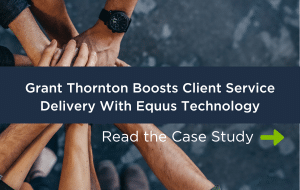Global Companies Should Leverage Technology and Look to Their International Postings to Increase Diversity within the Company
By Gareth Davies, VP Technology Solutions, Equus Software
Read the article on Global Banking and Finance Review
Employees want to work with inclusive and equitable companies. A CNBC/SurveyMonkey report found approximately 80% of workers want to join and stay with companies that support DE&I. This sentiment means companies that embrace DE&I and don’t just pay lip service will attract deeper candidate pools. This is especially vital with the modern global workforce and intense competition for skilled labor. Companies need all the reasons they can muster to stay relevant and appealing to the workforce. Supporting DE&I also drives hiring managers to remove biases, attract minority group talent, and ensure everyone receives equitable treatment.
Changing Policies and Tactics
Business leaders that want to develop strong diverse workforces need to build companies that encourage diverse candidates. A mobility team’s policies can shape a firm’s image in a way that transcends geographic borders and cultivates a lasting and equitable brand impression. Overseas posts at some companies are launching pads to leadership roles. Managers at companies that are serious about DE&I need to consider their global mobility tactics carefully, as they have far-reaching implications for the business’ ability to compete in a connected and diverse global marketplace.
Global mobility teams can begin by reviewing the written profiles of the desired talent they need for any global assignments. They might need to change their language and descriptions of the characteristics of people that are typically chosen for overseas postings. They can perform audits to see any unintentional biases within their past practices, whether this includes limited opportunities for certain races or those who identify within the LGBTQ+ communities.
Pairing the Right Candidate with the Right Role
HR and mobility teams need transparent and measurable actions to improve their role in a company’s broader DE&I efforts. Improving the equity of this process can come through simple steps, such as offering flexible benefits packages. For example, if candidates can create a “mix and match” benefits plan, then it gives them options to match their needs. This could mean a same-sex partnership with no children uses employer-offered school-related assistance for their own training classes or to learn the local language. Other flexible and DE&I-friendly options could include live-in partners receiving the same health benefits as married partners, or extended resources for assignees who are parents of kids with special needs.
Another role for teams is to spot factors that might result in failed assignments, whether that means the employee underperforms or there are other conditions that impede success. In the selection and planning phases, before an employee departs for their new post, teams need to consider DE&I efforts and if the employee will further those efforts in the role. Leadership should empower mobility teams to voice their opinions on candidate selections and to have control over certain elements that will improve the odds of success. This includes teams determining if an assignee’s identity and personal circumstances fit with a given role and locality. For example, a LGBTQ+ identifying staff member might not be the right fit for some Middle Eastern countries where same-sex partnerships are illegal, and the assignee might face open discrimination or hostility. Mobility teams should coordinate their efforts with managers and HR to move people towards the right assignments. Otherwise, when things don’t go well it can damage the company’s retention and business growth efforts.
Expanding Knowledge Bases
To spot potential problems and conflicts between assignees and their global assignments, mobility teams need more in-depth information and should transparently share this data with employees. They can provide assignees with cultural and demographic data about their new city or country. For example, a company expanding to an older city located within mountain ranges might relay the issues that city poses for someone with mobility issues. They could instead find someone different for the role, while also leveraging their knowledge to find the ideal mobility-friendly job and location for the person with the disability. Another example of a bad fit is a role in a country that lacks the proper advanced healthcare services for an assignee’s dependent who needs in-home care and specialized medical treatment.
Mobility staff need expansive skill sets beyond tracking assignees and managing paperwork. They require emotional intelligence, an ability to read people and situations, and to always work with sensitivity and discretion. They also might require new vendor partners who can provide them with the current conditions on the ground and key insights that are otherwise unavailable.
Using Technology for Privacy and Efficiency
Teams can leverage technology tools to oversee the complex elements of a global workforce. Platforms like those from Equus Software manage the routing of assignment letters, approvals, and other sequential choices that are best managed with automation. Using such a platform removes many manual tasks from teams, giving them more time for strategizing and matching candidates to opportunities in a way that supports their company’s broader DE&I efforts.
These platforms can also generate reports detailing current opportunity statuses, as well as a host of demographics information. Despite the capability of these platforms to produce analytics and insights, companies have limited inputs when it comes to their employees’ DE&I-related personal information. Due to privacy regulations, employee records do not contain data such as sexual orientation, religion, race, and other similar points. Of course, this is by design to prevent companies from ignoring new hires that fall into certain categories. Leadership and global mobility teams might see this lack of data as a roadblock, but for a business that embraces DE&I, it should not matter. If a company hires diversity candidates, promotes people based on merit, and is open to a wide range of assignees for global posts, then it is already building an inclusive and agile team.
A dynamic mobility solution will feature frequent country-by-country updates, which then create parameters for an employee’s actions, such as the duration of their stay and their specific actions when they’re in a new location. This prevents situations where HR needs to make guesses about the right process or policy. They can instead act with context and confidence and allow the organization to continue to reap the retention, cultural, and branding benefits of a globally connected and happy workforce.
For 2022 and beyond, the mobility “rulebook” is out the window. The new rules require nimbleness that’s possible with connected and reliable technology solutions. It’s essential for mobility teams to act proactively and manage staff who might spend six months remotely in Bangalore, eight in Boston, and then a year in the Dublin headquarters. Each location and work situation requires an understanding of local regulations, the person’s role, and other key factors that can influence risk outcomes. Manually managing this dynamic for 1,000 newly “untethered” employees is an unreasonable ask for compliance teams. They need technology solutions that automate consistent and data-driven policies that help a business excel in the global economy.





